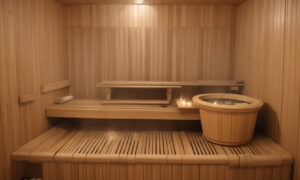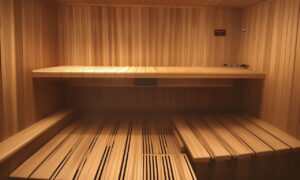Embarking on a sauna ritual is a journey to tranquility and invigoration, where the steam wraps you in a warm embrace, and each droplet of sweat seems like a toxin fleeing your body. But amidst this serene imagery, there’s a titillating question that often goes unnoticed – just how much water do we lose while surrendering to the gentle heat of a sauna?
In the depths of the heated haven, our bodies engage in an ancient form of purification, leading us to ponder about the surprising sweat secrets and the mysteries of our internal water reserves. Prepare to be drenched in knowledge as we delve into the enchanting world of saunas.
The Sauna Effect: Understanding Water Loss Through Sweat
The Process of Sweating in a Sauna Environment
Saunas are designed to elevate the body’s core temperature, triggering a natural cooling response – sweating. This process is not merely a release of water but a complex physiological reaction involving our sweat glands that helps maintain our body’s temperature equilibrium.
Related article; how much water do you lose in a sauna
Quantifying Sweat: How Much Do You Really Lose?
In a typical sauna session, which can range anywhere from 15 to 30 minutes, individuals can experience differing degrees of dehydration. Here are some surprising figures:
Related article; infrared sauna electricity cost
- During a moderate sauna experience, it’s possible to lose approximately 0.5 to 1.5 liters of water through sweat.
- Exceeding 30 minutes or increasing the heat can push this number higher, with some individuals experiencing up to 2 liters of water loss.
The Variables Affecting Sauna-Induced Dehydration
Several factors can influence just how much you’ll sweat out during a sauna session:
Related article; should you shower after sauna
- Body Size: Larger individuals generally have more body mass to cool down, which can lead to more sweat production.
- Temperature and Humidity: Higher temperatures and humidity levels within the sauna can amplify sweat loss.
- Duration and Frequency: Longer and more frequent sessions increase cumulative water loss.
The Fallout of Fluid Loss: Implications for Health and Wellbeing
Losing a significant amount of water can lead to dehydration if not properly managed. Understanding how to replenish fluid levels is crucial to harnessing the health benefits of a sauna while avoiding potential risks.
Related article; how long should i sit in sauna after workout
Replenishing Lost Fluids: The Hydration Equation
Estimating Rehydration Needs Post-Sauna
Upon exiting the warmth of a sauna, the immediate sense of lightness might be gratifying, but it’s paramount to calculate your rehydration needs to compensate for the fluid loss.
Related article; optimal sauna temp
Sweat Rate Calculation: A Simple Method
A straightforward method involves weighing yourself before and after the sauna visit. The weight lost is essentially the amount of water your body has dispelled during the sauna session.
Related article; shower sauna conversion kit
Rehydration Strategies: What to Drink and When
- Water: The quintessential rehydration fluid, consumed in gradual sips to restore hydration levels.
- Electrolytes: For intense sauna sessions resulting in significant sweat loss, a beverage containing sodium and potassium aids in balancing electrolyte levels.
- Timing: Begin rehydrating immediately after the sauna and continue drinking fluids over the next few hours to fully replenish lost water.
Exploring the Health Benefits and Risks of Sauna Use
The Sweaty Benefits: Potential Positive Outcomes of Regular Sauna Sessions
Frequent visits to the sauna can contribute to various health outcomes, attributable in part to the intense sweating and subsequent detoxification process:
Related article; when is the best time to sauna
- Improved Cardiovascular Function: The heat promotes blood vessel dilation, enhancing circulation.
- Muscle Relaxation: The warm environment aids in relieving muscular tension and discomfort.
- Stress Reduction: The calming effect of the sauna environment reduces stress hormone levels.
The Flip Side: Understanding the Risks of Excessive Water Loss
While there are substantial benefits, it’s imperative not to overlook the hazards associated with excessive water loss in a sauna:
Related article; sauna before or after cryotherapy
- Heat Exhaustion: A severe form of dehydration leading to dizziness, nausea, and fainting.
- Electrolyte Imbalance: Profuse sweating can deplete the body of essential electrolytes, resulting in cramps and other symptoms.
Sauna Intensity and Duration: Fine-Tuning Your Experience
Navigating the Heat: Ideal Sauna Temperatures for Optimal Experience
Sauna temperatures typically range from 70°C to 100°C (158°F to 212°F), providing a potent environment for sweating and relaxation. But finding your personal "sweet spot" can optimize both enjoyment and health benefits.
Customizing Session Length to Your Comfort Level
A key component of sauna safety and efficacy is tailoring the duration to your individual needs and tolerance:
- Beginner Sessions: It’s recommended to start with shorter sauna intervals of 5-10 minutes to acclimate your body.
- Intermediate Endurance: As your body adapts, you can comfortably extend sessions to 15-20 minutes.
- Expert Escapades: Seasoned sauna enthusiasts might indulge in sessions upward of 30 minutes, with appropriate hydration precautions.
After the Heat: Post-Sauna Recovery and Care
Cooling Down: Strategies for Post-Sauna Temperature Regulation
It’s essential not to shock the body after emerging from a sauna session:
- Gradual Cooling: Allow your body to cool down naturally in a temperate room or through a lukewarm shower.
- Hydrate Immediately: Reintroduce fluids slowly to avoid stomach discomfort.
Nutrition Post-Sauna: Supporting the Body’s Rehydration Process
Sweating profusely in a sauna can require not just fluid but nutrient replenishment:
- Eat Water-Rich Foods: Fruits and vegetables with high water content can aid in rehydration.
- Balance Your Electrolytes: Including a small amount of salt in your meal can help restore sodium levels.
FAQs: Sweating Out the Truth About Sauna Water Loss
Can You Lose Weight in a Sauna?
Yes, you can witness an immediate drop in weight due to water loss, but this is temporary. True weight loss comes from burning calories and fat, not from dehydration.
How Long Should You Stay in a Sauna?
The ideal session length varies but staying within 15-30 minutes is generally safe. Listen to your body and exit if you feel uncomfortable.
Is It Possible to Sweat Too Much in a Sauna?
Absolutely. Excessive sweating without proper hydration can lead to overheating and dehydration. Moderation and mindfulness are key.
In summary, the water loss experienced in a sauna is both wondrous and intricate, a ritual as much about renewal as it is about relaxation. By understanding the nuances of sweat and hydration, we can fully embrace the sauna’s embrace, exiting not just with a cleansed physique but an enlightened appreciation for our body’s remarkable resilience. Remember, a well-seasoned sauna enthusiast not only respects the power of heat but the sanctity of replenishment – a balance that keeps the sauna’s allure everlasting.




